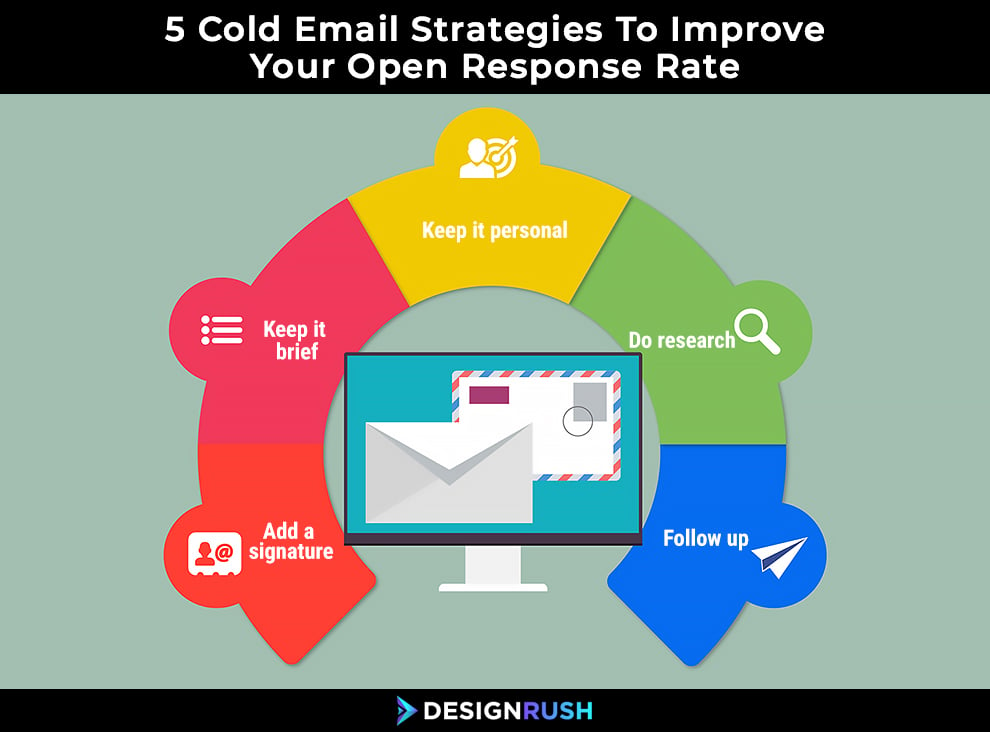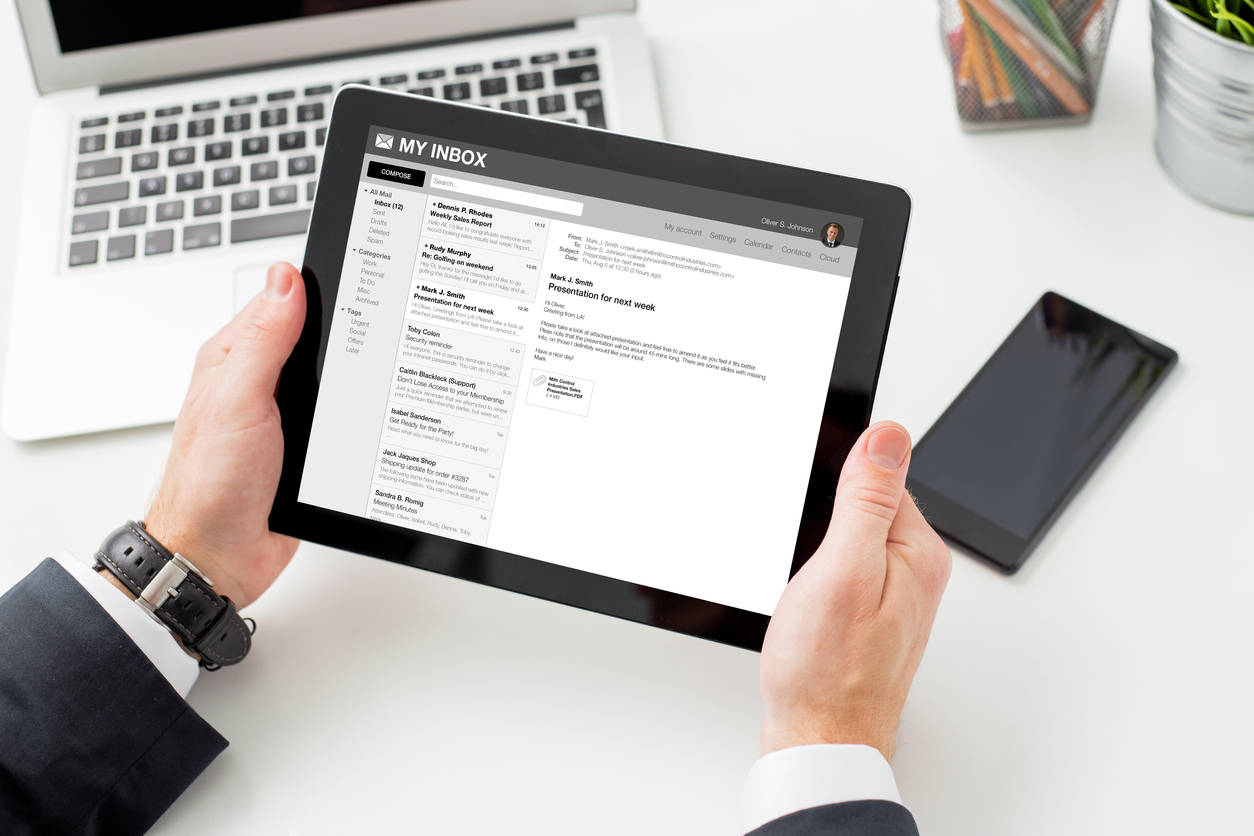We all get them. The generic cold email that starts with ‘Dear Sir’ and goes on to talk about a service or product that we have no care for.
Sometimes we call it spam.
Unfortunately, these spammy emails have made it difficult for companies to provide real value and reach potential prospects.
But there’s good news — we’re going to share a few tactics you can use to make your emails stand out from the crowd and actually receive a response.
First, let’s be clear about something — mass emailing does not work. Don’t blast stock requests to unwilling people. It’s better to have go-to people at companies and contact then one-by-one.
In order to be a successful marketer or business professional, you need to be a life-long learner. There are always new business ideas popping up, new ways of thinking and new strategies to adopt - such as these, used by any professional agency for digital marketing.
Table of Contents
- 1. Personalize Your Cold Email
- 2. Cold Emails Should Be About Them, NOT About You
- 3. Keep Emails Short And Include Plenty Of Breathing Space
- 4. Include Contact Information In Your Signature
- 5. ALWAYS Follow up
- How NOT To Structure A Cold Email
- How To Structure A GOOD Cold Call Email
- Improve Your Cold Email Open Response Rate In 5 Easy Steps
It was estimated that about 269 billion emails were sent every day in 2017. That’s 74 trillion emails every year. And that trend isn’t going away anytime soon.
Over the next four years, email use is expected to grow at an annual rate of 4.4 percent. In 2021 an average of 316 billion emails were sent every day.
To give you an idea of what benchmarks you should set and what KPIs you can strive to meet, here are some quick facts on average industry numbers when it comes to email response rates.
As of February 2018, the average open rate across all industries was 17.62 percent. On mobile, that rate went up to 59 percent. On desktop, that number was 69 percent.
Click-through rates averaged at about 7.97 percent. Bounce rate average was 9.45 percent.
Improving your email click-through rate and the response rate is likely a top priority for you and your business — whether you’re running widespread email marketing campaigns or sending smaller, more targeted emails.
But when it comes to cold calling, the more specific and personal, the better.
If you want your cold email to stand out, you’re going to have to put some work in. So let’s talk about how we’re going to make these emails effective — by getting them opened and getting a reaction.
And these five cold email strategies will put you on the right track, helping you improve your open response rate in no time.

1. Personalize Your Cold Email
Personalize the subject line and the greeting. The subject line should ideally include the company name you’re reaching out to or the individuals' name. This could be written out simply as Hello (Person’s Name) if you’re approaching an individual or something like (Company X Growth Results) if you’re approaching a business.
But whatever you do, don’t start the greeting with ‘Dear Sir’ or ‘Dear Madam’. People almost always associate the word ‘dear’ with spam emails. You don’t want people to be turned off before they ever get the chance to read what you’re trying to say.
To bypass the spam words, make your greeting more casual. Use the greeting ‘hello’ or ‘hi’ to make it more casual, personable and light. Try to include the person or business name.
Throughout the entire email, personalization is key. It shows the reader that you took the time out of your day to do some digging and uncover key facts about them and their business.
But the first place to have some fun with personalization is the subject line.
A personalized email with a subject line that references the person or company you’re trying to reach out to can increase your open rate significantly. This means that you will likely have to tailor each email to the individual you’re approaching.
It’ll require a little extra work, but it’ll be worth it in the end.
Have some fun and play around. Include the company name, mention a recent accomplishment on the part of the email recipient or mention them directly.
If an individual knows an email has been written for them specifically, they are more likely to not only continue reading but possibly even reply back.

2. Cold Emails Should Be About Them, NOT About You
Often times, in the first paragraph, marketers tell people who they are, what company they work for and what the company does in the hopes of enticing new clients and securing a new lead.
This is a BIG mistake.
Why? Because the reader doesn’t know who you are and doesn’t care. They will delete this email — even if they open it.
What you want to do instead is start by talking about their company. Put a sentence or two about why you’re reaching out to them and their company — use facts about their company or industry. Then tie it into how your company has helped companies in that industry. Get your inbound marketing team involved and get your hands on a link to a natural case study that will help them on their buyer's journey.
Do some research. Learn about the individual or company you’re making contact with. This will ensure your email has a personal, organic and human touch that will be hard for the recipient to ignore.
It’s also a good way of boosting the ego of whomever you’re reaching out to. If you make them feel special and make them feel like they are worth learning about and getting to know, you will make them want to reach back out and interact.
Don't include open-ended questions or email opt-in options. This takes the personality out of the email. Also, be wary of grammar errors. They break the natural flow of your email and make you look silly and unprofessional. Use an app like Grammarly to help keep your text free of grammar errors.
Dedication to researching your intended audience and personalizing your email as best you can is shown to double your reply rate. And at the end of the day, that’s what you’re looking for. You’re looking for new clients. You’re looking for new business. You’re looking for new leads.
Ensuring that your audience knows that this email was tailored specifically to them will help give you those results.
Admittedly, sometimes cold emails may not be the best outreach strategy. For example, SMS marketing boasts a 98% open rate and can cultivate individual conversations for younger generations. Understanding your audience with your outreach can generate the most successful campaigns.
3. Keep Emails Short And Include Plenty Of Breathing Space
No one likes to see a whole mess of text when they click on an email — especially if they’re on their phones. So keep it short, sweet and straight to the point.
Don’t write a big paragraph — no more than two sentences per paragraph is a sufficient amount to get your point across. And no more than five sentences total — this should equal out to about two to three paragraphs total.
You should include plenty of breaks between paragraphs and ideas. This gives the reader the time to breathe and digest the words they’ve just read. It also makes for a smoother reading process overall.

Seventy-nine percent of smartphone users read email on their phones, so you also need to keep in mind the medium in which your audience is viewing your emails. If their screen is cluttered up with big, clunky paragraphs then it’s likely they’ll exit out with actually interacting with the content.
If you feel that your emails are too long, then you can utilize a summarizer to make them concise while keeping the gist of the matter intact. Summarizers are online tools that can create summaries of the given text. Simply find one online and run your email’s content through it to make it smaller and to the point.
So to sum up the layout of your cold email, it should include one or two sentences at the beginning complimenting and acknowledging the accomplishments and the successes of the recipient.
Then the second paragraph should include one or two sentences that tie in how your company has had success in the past with similar companies or industries. You should always try to include clickable examples.
Then end your email with a line about how you will follow up on your correspondence.
“May I contact you next week?” is a solid, actionable follow-up email closing line.
This gives your intended target all the information they need in a quick and easy-to-digest way. It gets straight to the point. It is personal. It is full of valuable insights. And it lets the reader know what the next steps are in plain English.
With the number of emails we receive every day, we don’t have time to waste reading a lengthy, dull and impersonal email. You don’t have that time, and neither does your audience.
4. Include Contact Information In Your Signature
There are few things as unprofessional as not having a signature at the bottom of a professional email.
It tells your recipient that you are a professional. It tells people that you are established. It tells people that you are a leader in your field that should be taken seriously.
Without it, you could be any Joe Schmo on the street reaching out from a no-name company.
Without a proper email signature, neither you nor your email will be taken seriously — especially if you’re reaching out to another professional, whether in your field or in another. In the meantime, make sure to do a quick DMARC setup to secure your emails and domain from phishing and spoofing.
Before you send out a cold email especially, ensure you have a signature line with your email, phone number and company website listed. It doesn’t have to be extremely fancy or designed in an eye-catching way. It just needs to exist and provide your reader with all the information they will need to learn more.
And it’s important your signature is written out — not included as an image or graphic. Especially on mobile, these images take a while to load and often times look like broken files sitting at the bottom of your email.
Sometimes they show up as attachments which make readers wary — especially considering we are living in a time where cybersecurity is at the forefront of many professionals’ worries. They don’t want to risk opening an email or attachment from a sender they don’t know which could lead to the downloading of a virus.
You’re already at a disadvantage by reaching out to someone at random, at least in their eyes. So, you want to give them as little doubt as possible about your intentions, expertise or credibility. Ensuring that you have a visible, easy-to-read signature is one way to do that to encourage a response.
5. ALWAYS Follow up
Practice makes perfect, and persistence is key — especially when it comes to cold email campaigns. Sometimes it takes more than one try to hook a potential lead in. Sometimes it takes multiple emails to persuade them that your product or service is worth it. Different email marketing platforms like Klaviyo can help you generate follow-up email sequences for your campaigns. This can be much more efficient than manually doing this yourself.
Of course, you have to be careful not to bombard them with too many emails, as that is cited as the number one reason people unsubscribe from email lists. But it is important to make your presence known consistently.
The more you follow up, the better, according to an experiment by Woodpecker. This company found that when they sent one to three follow up emails, their reply rate was only nine percent. But when they increased the number in the follow-up sequence, that reply rate rose to 27 percent.
This is important to note, considering finding the email sweet spot can be challenging. But this study shows that the higher the volume at which you follow up, the better lasting impression you make.
It’s also important to let your recipient know that you will follow up. If they do end up reading your email, it lets them know that you aren’t going to give up and that they can expect another email packed with valuable information that they can use to make their final decision.
But also make sure to give them time. Waiting a week between follow-ups gives your audience enough time to interact with the email. And if they don’t, it’s still soon enough that you and your business are still in their minds and haven’t been forgotten about.
Following up with your recipient is imperative to ensure you build a lasting relationship that will end in a valuable lead — or even the following through of a purchase.
With all of these insights in mind, you should now be ready to get started on your next cold email campaign. But before we let you go, let’s talk about what cold email templates should look like — the good, the bad and the ugly.
Let’s start off by sharing with you an example of a bad cold email.
How NOT To Structure A Cold Email
First, we have to set the scene.
Let’s pretend your name is Joe and you’re contacting Sally. Joe works for a website design company called Web R Us. And Sally works for a real estate property group called Best Real Estates. Here’s an email for what not to write.
Subject line: Web r Us Is Web R us
Dear sir/madam,
My name is Joe and I work at Web R Us. We build websites. I have the best and cheapest rates. We beat any competition on rates. You can look at our portfolio on our website. You will like our work and we are happy to hear from you. Feel free to contact us at any date or time to talk more about what our designers can do for you. Our company has been in the business for over a decade and we’re the best in our industry. You need our services because we are the best and you can’t get our service or our rates anywhere else. Everyone needs a good website and we can build that website.
We are dedicated to our customers and we think you’d be a great fit as a future customer. We know what you’re looking for. We know what goes into creating a great website that will help you sell more, faster. We want to help you succeed as we are in the business of success. We can’t wait to hear from you about future projects.
Sincerely,
Joe
Web R Us
Notice what’s wrong with above — well, there is a lot wrong with the above so let’s break it down.
For starters, there is just too much text. In this entire email, there are 15 sentences! And those sentences are broken up into two huge, clunky and disorganized paragraphs. No one is going to want to read this dense material.
Not only that, but this is incredibly vague. There is no personalization, the subject line does nothing for Sally and the content doesn’t show any specialty on the part of Web R Us.
It’s jumbled, vague, uninteresting and hard to follow. Even if the reader does open the email — which after the subject line, they surely won’t — they will immediately close it upon seeing the text.
This email is all about Web R Us and not at all about Sally and her real estate company. It doesn’t show care or research or any effort at all. There is no call to action, no intent to follow up, and no contact information for Sally to learn more.
This is a prime example of a cold email that will inevitably flop.
How To Structure A GOOD Cold Call Email
Now that we know what cold email templates to avoid, let’s look at an example of what a good cold template looks like. This cold email will drive engagement and improve open response rates with ease.
Subject Line: Best Real Estate Digital Presence
Hi Sally,
Congrats on the new development property you’re building. I love the finishes on your property and it would be a dream of mine to live in one of them.
We specialize in custom websites for the high-end real estate industry. We just launched a website for company X. I’d love to talk to you about some ideas I have to create a site that is worthy of your properties values.
May I contact you for a follow up next week?
Best,
Joe King
E: joe@webrus.com
P: 713-454-9968
W: www.webrus.com
Notice the above follows our outlined cold email best practices — it shows his experience and why he’s reaching out.
It’s short. It’s concise. It meticulously details what is wonderful about Sally’s business, compliments her on recent successes and shows clearly and with examples how Joe can help her website shine.
There is an obvious personal touch, a subject line that pulls the reader in and is catered to them specifically and clear examples and calls to action.
Sally knows what Web R Us can do. She knows, more specifically, what they can do for her. And she knows how she can learn more — by reaching out via email, phone or waiting for the follow-up email that will arrive in her inbox in just one week.
Whether sitting at her desk or reading on her phone — this email is one Sally will be happy to receive.

Improve Your Cold Email Open Response Rate In 5 Easy Steps
No one likes spam, and unfortunately, most email marketers these days don’t know how to create a cold email that doesn’t read like a robot created it.
People want to know they’re interacting with human beings — and you can’t forget to include that emotional, human element into your emails. Otherwise, you’ll be wasting your time sending out bland emails that will never get you the leads you’re looking for.
To create a cold email that’ll increase your open response rate significantly, you need to follow these five strategies:
- Personalize your cold email
- Cold emails should be about them, not about you
- Keep the email short and include plenty of breathing space
- Include contact info in your signature
- Always follow up
Cold email outreach can be tricky. It can be time-consuming, exhausting and difficult. It requires extensive research, creativity and follow-up emails which lengthen the process even more. It requires constant communication across a variety of departments — from sales reps to social media marketing teams and everyone in between.
But these business emails can make or break your company’s future. So you need to have the right skills to succeed. Sales emails tend to be boring and bland, but cold email outreach can't afford to fall flat.
If you keep these tips in mind, you’ll be seeing those leads fly in. Business will boom, your superiors will be happy and you’ll be seen as an email marketing guru. It’s time to embrace the human element in marketing, and all it takes is some time, research and a five sentence email to get started.



-preview.jpg)





